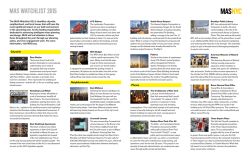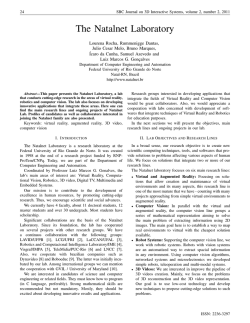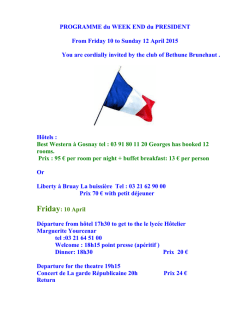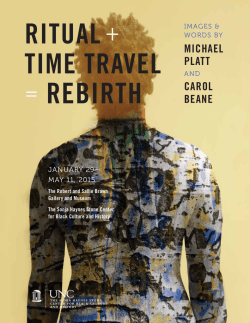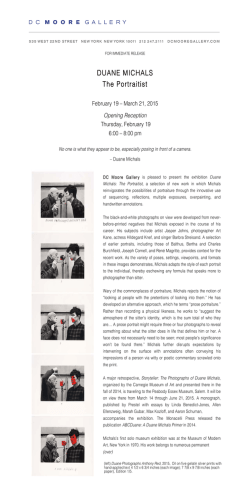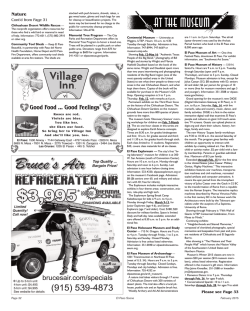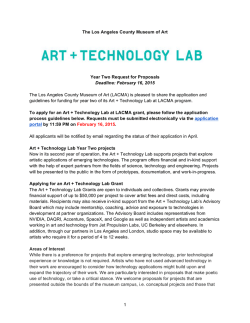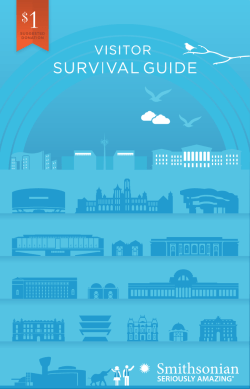
events calendar - Indiana University Art Museum
Non Profit Org. U.S. Postage PAID Permit No. 171 Bloomington, IN EVENTS CALENDAR Indiana University Art Museum 1133 East Sevent h St r eet Bloomington, IN 47405–7509 January & February 2015 Volume 11 | Issues 1 & 2 INDIANA UNIVERSITY A R T M USE U M January 2015 16 Friday 3:00–4:00 p.m. | One-Hour Exhibition Jacques Villon 18 Sunday 2:00–2:30 p.m. | Art and a Movie Arbus in Focus S M T W T F S 1 2 3 4 5 6 7 8 9 10 11 12 13 14 15 16 17 18 19 20 21 22 23 24 25 26 27 28 29 30 31 3:00–5:00 p.m. | Art and a Movie Fur: An Imaginary Portrait of Diane Arbus 28 Wednesday 12:15–1:00 p.m. | Noon Talk Southwestern Native American Art February 2015 7 Saturday 2:00–3:00 p.m. | Thematic Tour Light Totem 11 Wednesday 12:15–1:00 p.m. | Noon Talk Winston Churchill S M T W T F 1 2 3 4 5 6 S 7 8 9 10 11 12 13 14 15 16 17 18 19 20 21 22 23 24 25 26 27 28 13 Friday World War I Commemoration at the IU Art Museum Throughout the 2014/15 academic year, Indiana University is commemorating the centennial of World War I, which was declared on July 28, 1914. At the IU Art Museum, a special installation, Dada and Constructivism: World War I and Radical Modernism, illustrates how the war inspired artists to seek new directions in their art. The installation features works from the museum’s permanent collection by five artists who were active in the postwar Dada and Constructivist movements: Theo van Doesburg, Kurt Schwitters, Alexander Rodchenko, Man Ray, and Marcel Duchamp. Despite representing artists of five nationalities—Dutch, German, Russian, American, and French—the stylistic and conceptual connections among the works underscore the internationalism of avant-garde art in the early twentieth century. In particular, these artists—whether traumatized by their experiences on the battlefield or socially marginalized as conscientious objectors—sought to question the social, political, and artistic status quo. In the years immediately following World War I, they pioneered radical approaches to artistic creation, including non-objectivity, assemblage, and the concept of the “readymade,” where found or manufactured objects are designated as works of art. Their experimentation had a profound influence on the development of art throughout the twentieth century and continues to inspire artists working today. “Wilderness, to me at least, is a ‘mystique’: a valid, intangible, non-materialistic experience.” —Ansel Adams The installation is accompanied by a free brochure, with an essay placing the objects in their historical and aesthetic contexts. More information and a calendar of related events can be found on IU’s World War I: 100 Years web site: rememberingworldwari.indiana.edu. 1:00–3:00 p.m. | Special Program From the HeART Ansel Adams (American, 1902–1984). Aspens, Northern New Mexico, 1958. Gelatin silver print. IU Art Museum 76.65.7. © 2015 The Ansel Adams Publishing Rights Trust Images: 20 Friday 3:00–4:00 p.m. | One-Hour Exhibition FSA Photos Top right: Kurt Schwitters (German, 1887–1948). Merzbild 13A. Der kleine Merzel, 1919. Mixed media, Jane and Roger Wolcott Memorial, Gift of Thomas T. Solley 75.39 Bottom right: Man Ray (American, active France, 1890–1976). The Engima of Isidore Ducasse, 1920 (1971 edition). Mixed media. IU Art Museum 71.95.2 ANGLES CAFÉ & GIFT SHOP Museum Winter Break Hours IU Art Museum will be closed for New Year’s Day, Thursday, January 1, 2015. From Friday, January 2, through Sunday, January 11, the galleries will be open noon–5 p.m. (closed Mondays). Last fall, Angles manager and buyer Murat Candiler was invited to two events in Brazil promoted by the Brazilian foreign trade organization APEX. Along with seven other buyers from France, Switzerland, Germany, Japan, and the U.S., Murat was introduced to several artists and art galleries specializing in indigenous handcrafts and attended a fashion show. As a result of this opportunity, Angles now features original jewelry, ceramics, woodwork, and scarves handcrafted by a remarkable group of Brazilian artisans. “As well as having 241 indigenous peoples, Brazil—the world's fifth largest country—has many talented artists with creativity, vision, dreams, and joie de vivre unlike anywhere in the world,” says Murat Candiler. Angles Café and Gift Shop will be closed through Monday, January 5. From Tuesday, January 6, through Saturday, January 10, Angles will be open 11 a.m.–5 p.m., and on Sunday, January 11, it will be open noon–5 p.m. Regular hours resume for the galleries and Angles Café and Gift Shop on Monday, January 12. The Art Museum building will be closed on Monday, January 19, in observance of Martin Luther King Jr. Day. Watch for Angles’ special Valentine’s Day sale event in February! All museum events are free & open to the public; seating is limited. Nature’s Small Wonders: Photographs by Ansel Adams January & February 2015 www.artmuseum.iu.edu When the Sycamore Land Trust approached the museum about installing a special display in honor of their twenty-fifth anniversary, the first artist who came to mind was Ansel Adams. America’s most famous nature photographer, Adams was also an ardent conservationist who served on the board of directors for the Sierra Club for thirty-seven years and was active in the Wilderness Society. He used his dramatic black-and-white photographs to encourage the preservation of America’s natural wonders, particularly those found in the U.S. National Parks. Employing his famed “zone system,” Adams created crisp, modern images with a romantic sensibility that sought out the spiritual force in nature. Adams believed that artists and environmentalists shared common ground: both were concerned with the “affirmation of life.” Adams’s images conveyed the sanctity of wild places, a fundamental concept of the environmental movement. Although Adams is best known for his grand, sweeping views of Yosemite National Park, he also produced many “macro” photographs of smaller details found in the natural world. In his introduction to the Sierra Club’s Portfolio One, Adams stated that he sought “to photograph truthfully and effectively… to see beneath the surfaces and record the qualities of nature and humanity which live or are latent in all things.” Whether his subjects were large or small, Adams coaxed remarkable nuances of light and shadow out of every image. While his close-ups suggest an affinity with other California modernist photographers, there is a dense, tactile quality to Adams’s pictures taken on site that differs from their cool, minimalist images of natural objects photographed in a studio setting. This installation features eight of Adams’s more intimate views of flowers, leaves, roots, rocks, and water ripples, as well as this elegant photographic frieze of the Rocky Mountains’ Quaking Aspen trees (which have been mysteriously dying off in large numbers since 2006 due to Sudden Aspen Decline [SAD]). Nanette Esseck Brewer The Lucienne M. Glaubinger Curator of Works on Paper This installation is on view from January 13 through May 24, 2015, in the Gallery of the Art of the Western World, Doris Steinmetz Kellett Endowed Gallery of TwentiethCentury Art. It is presented in conjunction with the twenty-fifth anniversary of the Sycamore Land Trust, whose mission is to protect the beautiful natural and agricultural landscape of southern Indiana. IU ART MUSEUM INFORMATION FOCALPOINT Traditional Changes: Art from the American Southwest Continuing through February 15, 2015 Raymond and Laura Wielgus Gallery of the Arts of Africa, the South Pacific, and the Americas, Focalpoint, third floor What does it mean to call an object “traditional” or “authentically Native American”? Explore these questions through examples of basketry, ceramics, textiles, and jewelry. Organized by Emma Kessler, curatorial assistant for the arts of Africa, the South Pacific, and the Americas. Fantastic African Hats: Power, Passage, and Protection February 17–May 24, 2015 Raymond and Laura Wielgus Gallery of the Arts of Africa, the South Pacific, and the Americas, Focalpoint, third floor The twelve richly embellished African hats displayed here celebrate the prestige of their owners, evoke complex histories of trade and commerce, and provide protection from harm. Organized by Brittany Sheldon, graduate assistant for the arts of Africa, the South Pacific, and the Americas. NEW IN THE GALLERIES January 13–May 24, 2015 Gallery of the Art of the Western World, Doris Steinmetz Kellett Endowed Gallery of Twentieth-Century Art, first floor WWI War Bond Posters During World War I, mass-produced color posters encouraged enlistment, helped raise capital for the war effort, and solidified public opinion against the enemy. Two vintage posters for war bonds, one American and one French, are featured: although both depict a German soldier, they have very different styles and impacts. Nature’s Small Wonders: Photographs by Ansel Adams (See cover story.) Finding Atget French photographer Eugène Atget’s imagery mixed a nineteenthcentury aesthetic with a modern sensibility, garnering him admiration and respect from the young Berenice Abbott, who became his champion. This installation features a vintage print by Atget and several later prints from his original negatives. Women behind the Camera The world of professional photography in the early- to mid-twentieth century was largely a men’s club, but a small group of talented women paved the way for future generations of female “lensmen.” Portraits by three of these pioneers—Imogen Cunningham, Berenice Abbott, and Toni Frissell—are featured. January 27–May 24, 2015 Gallery of the Art of the Western World, Doris Steinmetz Kellett Endowed Gallery of Twentieth-Century Art, first floor Pop Textiles Textiles designed by Pop artists Roy Lichtenstein, Richard Lindner, and Claes Oldenburg are featured. These bold and inventive compositions on fabric blur the boundaries between fine art, craft, and industrial production. Gallery of the Art of the Western World, first floor Robert Salmon: Romantic Painter Two paintings by Robert Salmon help elucidate the artist’s foundation in English Romanticism, which continued to inform his painting after his move to Boston in 1828. Raymond and Laura Wielgus Gallery of the Arts of Africa, the South Pacific, and the Americas, third floor Recent Acquisition: An Exquisite Nupe Wrapper Thanks to the generosity of IU Art Museum docent Paula Sunderman, the museum recently purchased three beautiful West African textiles, including a wrapper created by a Nupe weaver, currently on display. Abundant woven geometric and figural motifs make the cloth unusually refined and complex. ONE-HOUR EXHIBITIONS Please meet in the museum's third floor office. No pre-registration is required, but space is limited. Admission will be on a first come-first served basis. Jacques Villon Friday, January 16, 3:00–4:00 p.m. In order to distinguish himself from his family of talented artists (including his younger brother Marcel), Gaston Duchamp changed his name to Jacques Villon. Nan Brewer, the museum’s Lucienne M. Glaubinger Curator of Works on Paper, will discuss a selection of Villon’s prints in a variety of techniques that trace his evolution from Neo-Impressionist to Cubist. Farm Security Administration Photographs Friday, February 20, 3:00–4:00 p.m. In 1935 the U.S. government began an ambitious photo-documentary project under the auspices of the Farm Security Administration (FSA) intended to show the hardships of the Depression and the benefits of the New Deal. Curator Nan Brewer will discuss works by artists including Walker Evans, Dorothea Lange, Ben Shahn, Marion Post Wolcott, and Russell Lee. THEMATIC TOURS Light Totem Saturday, February 7, 2:00–3:00 p.m. SPECIAL PROGRAMS NOON TALKS From the HeART Tradition and Authenticity in Southwestern Native American Art Friday, February 13, 1:00–3:00 p.m. Thomas T. Solley Atrium Did you forget to make your sweetheart a Valentine? Are you feeling festive? This Valentine’s Day-themed event features a paper-flower activity, card-making station, live music, and a special performance of the balcony scene from Romeo & Juliet, courtesy of the IU Theatre. Angles Gift Shop will offer last-minute gifts for purchase. Refreshments and art activity supplies will be provided. LIFELONG LEARNING CLASS Provenance: Art Looting, Art Markets, and Art History Wednesdays, February 4, 11, and 18, 11:00–12:30 p.m. IU Art Museum, Meet in the Thomas T. Solley Atrium, first floor During the Nazi era and World War II, thousands of art objects changed hands—many as a result of looting—and determining an artwork’s whereabouts between 1933 and 1945 is a top priority for most museums. Presented by Jenny McComas, IU Art Museum’s Class of 1949 Curator of Western Art after 1800 and head of the museum’s Nazi-Era Provenance Research Project, this course examines Nazi art looting and the wartime art market, current provenance research resources and initiatives, case studies from the IU Art Museum’s collection, and how provenance research is changing our understanding of art history by bringing to life new facets of an art object’s past. To register, visit lifelonglearning.iub.edu or call 812-855-9335. ART AND A MOVIE This program is presented in conjunction with IU Cinema and is sponsored in part by Marsha R. Bradford and Harold A. Dumes. The talk and films are free and open to the public. Arbus in Focus Sunday, January 18, 2:00–2:30 p.m. Gallery of the Art of the Western World, Doris Steinmetz Kellett Endowed Gallery of Twentieth-Century Art, first floor Curator Nan Brewer will discuss works by the iconic photographer Diane Arbus, including an early fashion image and two mature works that reflect her distinctive “snapshot” aesthetic. Wednesday, January 28, 12:15–1:00 p.m. Raymond and Laura Wielgus Gallery of the Arts of Africa, the South Pacific, and the Americas, third floor The terms tradition and authenticity, although commonly used in discussing Native American art, are frequently misunderstood. Emma Kessler, curatorial assistant for the Arts of Africa, the South Pacific, and the Americas, will consider the development of traditions and the nuances of authenticity as seen in objects in the Focalpoint installation Traditional Changes: Art from the American Southwest. Winston Churchill: Artist, Writer, and Statesman Wednesday, February 11, 12:15–1:00 p.m. Gallery of the Art of the Western World, Doris Steinmetz Kellett Endowed Gallery of Twentieth-Century Art, first floor In his forties, Churchill (1874–1965) took up painting and eventually became not only a competent artist, but also a thoughtful student who loved to study art in the larger context of political and social history. Michael Sheldon, professor of English at Indiana State University and author of Young Titan: The Making of Winston Churchill, describes Churchill’s efforts as both statesman and creative individual. Images from left to right: 1. Berenice Abbott (American, 1898–1991). Portrait of Eugène Atget, 1927/printed ca. 1955. Gelatin silver print. IU Art Museum 76.128.5A 2. Yoruba peoples, Nigeria. Crown, twentieth century. Glass beads, cotton, fiber, wood, thread. Gift of Budd Stalnaker, IU Art Museum 2006.405 3. Frederick Strothmann (American, 1872–1958). Beat Back the Hun with Liberty Bonds, 1918. Color lithograph on paper. Gift of Dr. Kathleen A. Foster, IU Art Museum 90.6 4. Eugène Atget (French, 1857–1927). Staircase Rail, Versailles, France, ca. 1900. Albumen print. IU Art Museum 75.7.2 5. Roy Lichtenstein (American 1923–1997). Thunderbolt, 1966. Felt. Jane and Roger Wolcott Memorial, IU Art Museum 68.148 6. Nupe peoples, Nigeria. Woman’s Wrapper (detail), mid-twentieth century. Cotton, rayon. Museum purchase with funds from Paula W. Sunderman, IU Art Museum 2014.28 7. Marion Post Wolcott (American, 1910–1990). Child of a Coal Miner. Jere, Scotts Run, West Virginia, 1938. Gelatin silver print. Henry Holmes Smith Archive, IU Art Museum 200.XX.4.70 8. Jacques Villon (French, 1875–1963). The Game of Backgammon, 1903. Color aquatint and etching on paper. IU Art Museum 76.2.1 Admission and events are free and open to the public; seating is limited. The IU Art Museum is able to provide these excellent, free programs thanks to our donors. To make a gift or for more information, please contact Patty Winterton at [email protected] or 812-855-1031. Gallery Hours Tuesday–Saturday, 10:00 a.m.–5:00 p.m. Sunday, noon–5:00 p.m. Please see events flap for holiday hours and closings. Tour Information (812) 855-7719 Special Exhibitions & Events Information (812) 855-5445, Monday–Friday, 8:30 a.m.–5:00 p.m. (812) 855-4826, all other times Accessibility The museum is accessible to people with disabilities. Please call (812) 855-5445 for assistance. The museum offers audio description and touch tours for people with low vision. Please contact Patsy Rahn, the museum’s tour coordinator at [email protected] for more information. Angles Café & Gift Shop Hours Monday through Friday, 8:00 a.m.–5:00 p.m. Saturday, 10:00 a.m.–5:00 p.m. Sunday, noon–5:00 p.m. (812) 855-4337 Fur: An Imaginary Portrait of Diane Arbus Sunday, January 18, 3:00–5:00 p.m. IU Cinema Featuring actors Nicole Kidman, Robert Downey, Jr., and Ty Burrell, Steven Shainberg’s fictionalized account of the early career of Diane Arbus (Kidman) traces her artistic and personal transformation. (U.S., 120 min., rated R.) Presented by IU Art Museum Docent Becky Hrisomalos. January & February 2015 www.artmuseum.iu.edu Location & Parking The IU Art Museum is located at the heart of the Bloomington campus on Seventh Street, adjacent to Showalter Fountain. Parking is available close by at the Jordan Avenue pay-parking garage (across from the Musical Arts Center) as well as at the Indiana Memorial Union. Bring your IMU parking ticket to the museum information desk for a discount validation. Parking is free on Saturdays and Sundays in the parking garages on Jordan Avenue and Fee Lane (behind the IU Kelley School of Business). Handicapped parking and a limited number of metered spots are available in the small parking lot directly behind the museum. During Construction The Art Museum’s parking lot remains accessible to visitors via the service driveway that runs behind the Radio & TV building. © 2015, Indiana University Art Museum. All rights reserved. Produced by IU Art Museum Publications.
© Copyright 2026
